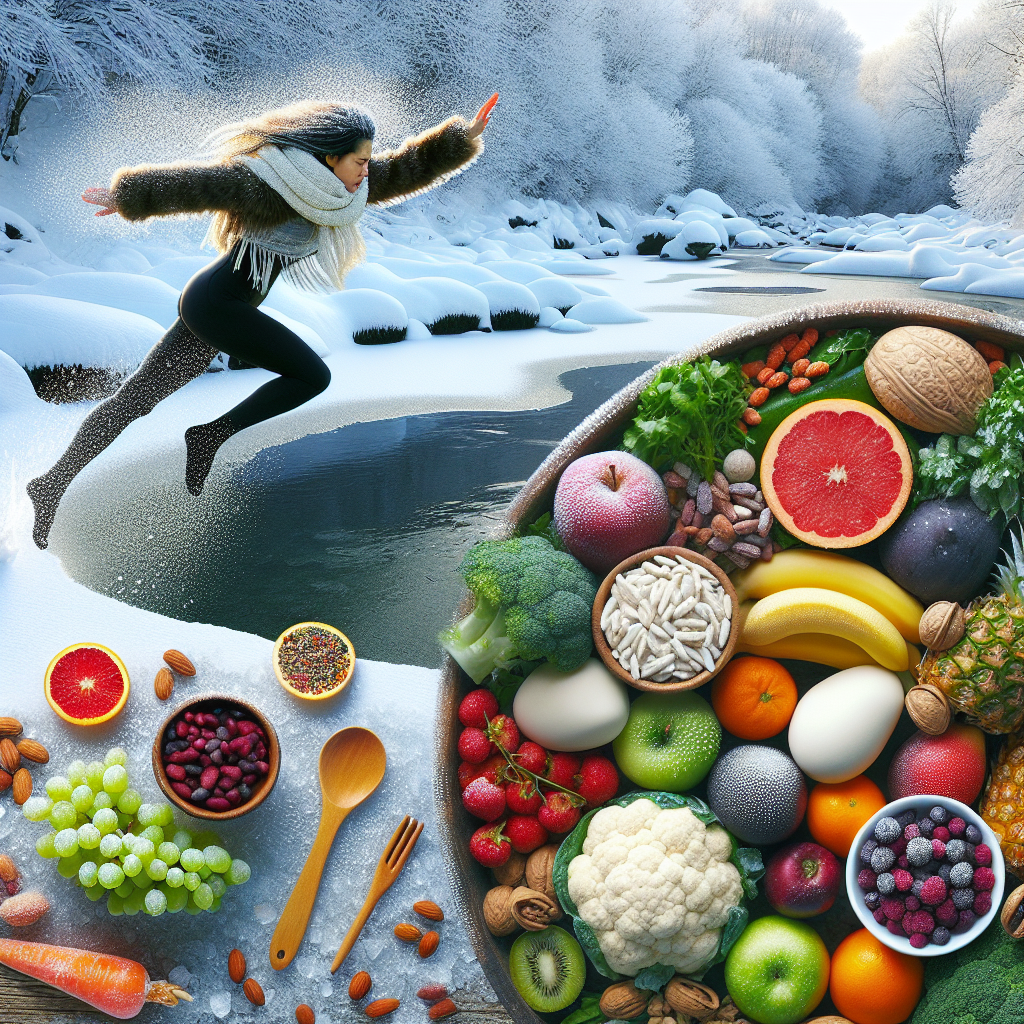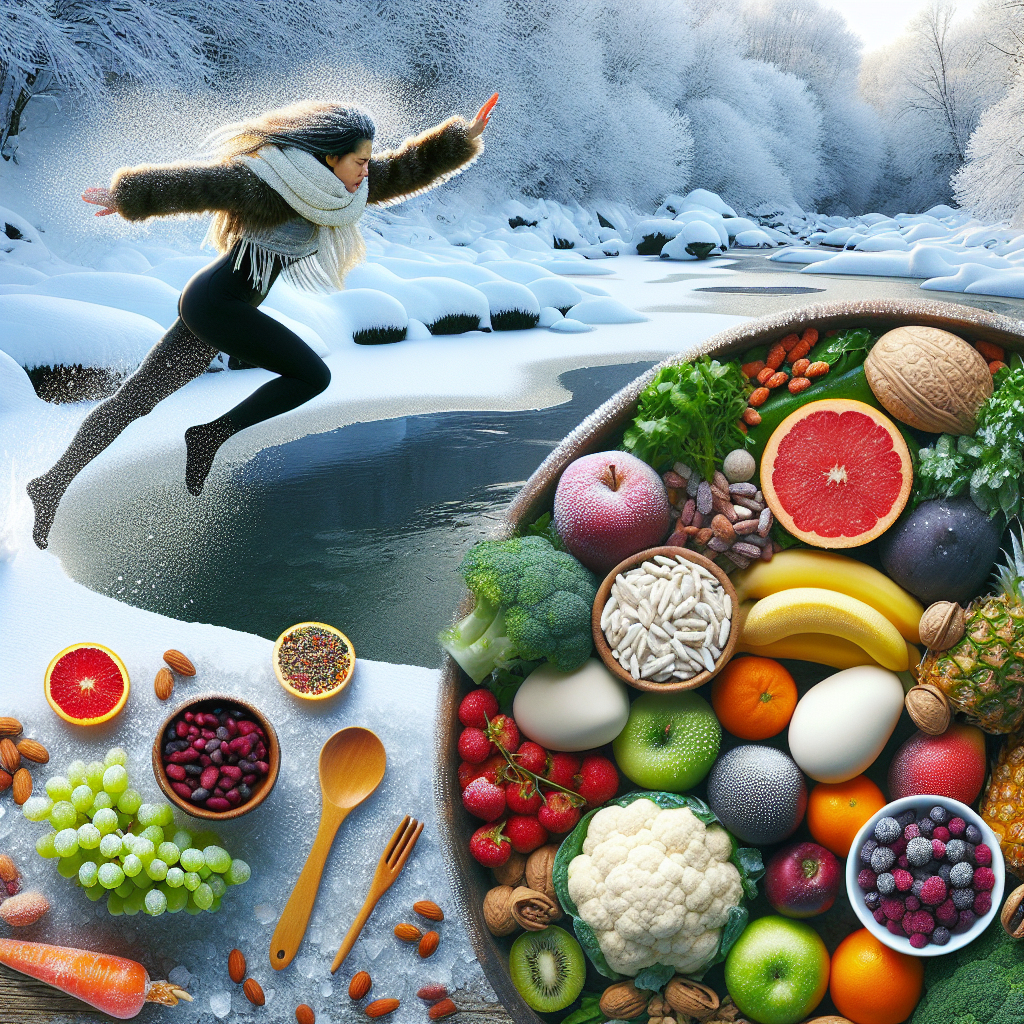Have you ever wondered about the relationship between taking cold plunges and your dietary habits? You’re about to embark on an enlightening journey as you explore this fascinating link. This article will offer eye-opening insights on how the refreshing chill of a cold plunge can complement your nutrition plan, boosting your overall health and wellbeing. Get ready for this chilly escapade that will take your lifestyle to invigorating new heights!

What are cold plunges?
Cold plunges, known to some as ice baths, are exactly what they sound like: immersions into cold water for a specified period of time. This practice is no novelty; humans have been intentionally exposing their bodies to icy temperatures for centuries. But why would anyone willingly choose to endure the shocking chill of a cold plunge?
Definition of cold plunges
A cold plunge refers to the practice of submerging oneself in cold water, usually around 10 to 15 degrees Celsius (50 to 59 degrees Fahrenheit) for several minutes. This can be achieved with a specialized cold plunge pool, a filled bathtub, or even in nature if the conditions are right.
History of cold plunges
Cold plunges have been around since ancient times, used by the Romans in their bathing rituals and by Finns in their sauna culture. Even the great philosopher Hippocrates endorsed the healing power of cold water, claiming it as medicine that could boost vitality and promote good health. So, this mind-numbing practice has been woven into the fabric of human wellbeing for millennia.
Benefits of cold plunges
The benefits of cold plunges are vast, with impacts on both mind and body. Diving into chilly waters can jog your nervous system, increase your alertness, reduce muscle inflammation, and improve blood circulation. Furthermore, some studies suggest that cold-water immersion can even boost your mood and alleviate symptoms of depression.
Understanding the impact of cold plunges on the body
Now that we’ve covered the basics of cold plunges and their proven benefits, let’s delve deeper into their impact on the body, particularly on metabolism, fat burning, weight loss, and immune function.
Effects of cold plunges on metabolism
When you expose your body to cold temperatures, it has to work harder to maintain your core body temperature. This results in an increase in your metabolic rate, which is the amount of energy your body uses to perform basic functions.
Influence on fat burning and weight loss
Cold plunges help your body naturally burn more calories, thanks to the increased metabolic rate we just discussed. Furthermore, cold exposures stimulate the production of brown fat—the good kind of fat. Brown fat is metabolically active and burns calories when stimulated, which can aid weight loss.
Impact on the immune system
Cold plunges can also provide a boost to your immune system. Cold exposure promotes the production of white blood cells in your body, which help fight off infections and disease.
The role of diet in conjunction with cold plunges
Cold plunges and diet are like two peas in a pod—they both play a crucial role in your overall wellbeing. Therefore, it’s crucial to understand the interaction between them.
Importance of a balanced diet
Regardless of whether you’re taking cold plunges or not, a balanced diet is essential. Consuming a variety of nutrient-dense foods provides your body with the fuel it needs to function optimally, this becomes particularly important when adding the act of cold plunging.
Nutrient absorption and utilization
Cold plunges impact the way your body absorbs and utilizes nutrients. With an increased metabolism, your body may need additional nutrients to accommodate the higher energy demands resulting from cold plunges.
Incorporating cold plunges into dietary routines
Cold plunges should be considered alongside your dietary routine. If you’re planning on plunging regularly, you might need to adjust your food intake to ensure your body is getting the nutrients it needs to recover and thrive.

Dietary considerations for optimal cold plunge benefits
To reap the most benefits from cold plunges, you’ll need to pay particular attention to your hydration, protein intake, and consumption of healthy fats.
Hydration and electrolyte balance
Cold plunges can potentially lead to dehydration, as the cold can suppress the urge to drink. Therefore, it’s crucial to stay adequately hydrated, and maintaining a proper electrolyte balance is equally important.
Protein intake and muscle recovery
Cold plunges can enhance muscle recovery after strenuous exercise. However, this process requires adequate protein to rebuild the muscle fibers effectively. So, ensuring enough protein intake is indispensable for individuals engaged in regular cold water immersions.
Consuming healthy fats for insulation
Healthy fats play a crucial role in shielding your body from extreme cold, acting as a form of insulation. Eating plenty of healthy fats can increase the effectiveness of your cold plunge practices by helping you tolerate and recover from the cold.
Cold plunges as a catalyst for dietary changes
In addition to its direct impacts, cold plunges can also be a catalyst for positive dietary changes. It can foster an increased mindfulness towards food, affect your hunger and cravings, and even cultivate discipline and willpower.
Increased mindfulness towards food
When you start noticing how cold plunges affect your body, you’re likely to become more aware of what you eat. This increased mindfulness can result in healthier food choices over time.
Positive effects on hunger and cravings
Some people find that cold plunges help curtail their hunger pangs and cravings for unhealthy foods. This may be due to the stimulation of brown fat, which improves insulin sensitivity and reduces hunger and cravings.
Building discipline and willpower
Regularly taking cold plunges can also strengthen your discipline and willpower. It takes mental fortitude to plunge yourself into a freezing onslaught willingly—skills that can readily transfer to maintaining a healthy diet.
Integrating pre and post-plunge meals into a nutritional strategy
Your dietary strategy should not just accommodate for cold plunges, but also use them to enhance the effectiveness of your meals, especially the meals consumed before and after plunges.
Fueling the body before a cold plunge
Before your plunge, it’s essential to fuel your body with easy-to-digest nutrients. These provide the energy needed to heat your body in the cold water. Good options include carbohydrates like fruits or oats, which provide a steady energy release.
Optimal nutrient timing after a cold plunge
After a cold plunge, your body needs nutrients to recover and replenish its energy. Eating a balanced meal with a mix of carbs, protein, and fats is vital to restore the balance in your body.
Specific food suggestions for pre and post-plunge
Specific food suggestions could include consuming a banana or oat porridge before your plunge for slow-release energy. Post-plunge, you might opt for a balanced meal like grilled chicken with sweet potatoes and a handful of mixed nuts, which provides an ample balance of protein, carbs, and healthy fats.
The potential synergy between cold plunges and specific diets
Different diets can evoke different responses from the body, especially when combined with cold plunges.
Ketogenic diet and cold plunges
For those on a ketogenic diet, cold plunges can be an effective way to get into ketosis quicker, due to the increased fat burning ability of the body in cold conditions.
Intermittent fasting and cold plunges
For the intermittent fasters, cold plunges could potentially suppress appetite during fasting periods and aid with productive fat burning, making the fast easier and more beneficial.
Plant-based diets and cold plunges
And for those on plant-based diets, the anti-inflammatory properties of cold plunges can be particularly beneficial considering the diet’s high antioxidant content, thereby creating a synergistic effect.
Addressing potential challenges in combining cold plunges and diet
Combining cold plunges with diet is not without challenges, such as managing an increased appetite, overcoming food cravings, and sustaining energy levels.
Managing increased appetite
Your increased metabolic rate after a cold plunge can lead to an increased appetite. It’s crucial to manage this hunger responsibly by feeding your body nutrient-dense foods that satiate without overeating.
Overcoming food cravings
Cravings, particularly for high-sugar foods, may surge due to the temporary increase in your metabolism. Dealing with these cravings involves creating a balanced diet strategy that includes nutritious food you enjoy.
Sustaining energy levels
Sustaining energy levels can be a challenge when you’re taxing your body with cold plunges and possibly restricting your diet. Regular, balanced meals and strategic snacking can help maintain energy levels.
Personal experiences and testimonials
As with any health practice, individual experiences with cold plunges and diet vary.
Individual stories and transformations
There are numerous stories of people experiencing significant positive transformations, from weight loss to improved mental clarity, after incorporating cold plunging into their lifestyle.
How cold plunges influenced dietary choices
Many individuals share that taking cold plunges directly influenced their dietary choices. They became more conscious of the foods they consumed and made healthier choices to accommodate and enhance their cold plunge practice.
Lessons learned from combining cold plunges and diet
Most individuals who combine diet with cold plunges stress the importance of listening to your body and adapting both dietary habits and the cold plunge practices accordingly.
Conclusion
The connection between cold plunges and diet runs deep, with each enhancing the benefits of the other.
Summary of the connection between cold plunges and diet
Cold plunges can boost your metabolism, aid in weight loss, enhance muscle recovery, and even improve immune function. When paired with a well-planned diet, these benefits can be augmented, leading to overall improved health and wellbeing.
Tips for incorporating cold plunges into a balanced diet
To maximise the benefits of cold plunges, remember to stay hydrated, consume enough protein for muscle recovery, keep your energy levels up with balanced meals, and listen to your body. Adapting and personalizing your diet and cold plunge practices should always be based on feedback from your body.
Importance of individual experimentation
As the personal stories show, there isn’t a one-size-fits-all approach for combining cold plunges and diet. It’s essential to find what works best for your body, experiment with different strategies, and constantly evaluate your progress. With persistence and mindfulness, you’ll be able to find an approach that optimizes your diet and cold plunge practices for your unique body. After all, personal health is a journey of continual exploration and learning. Happy plunging!
